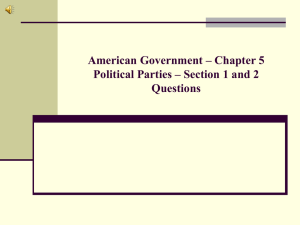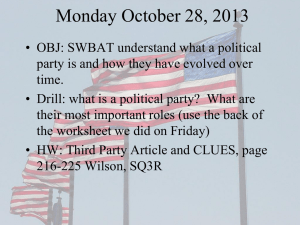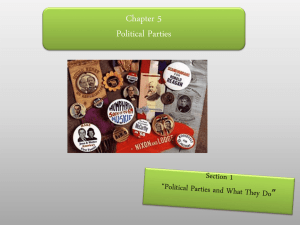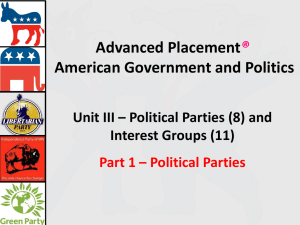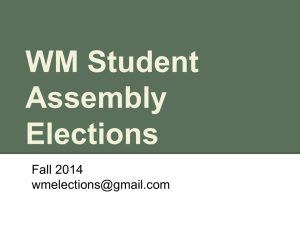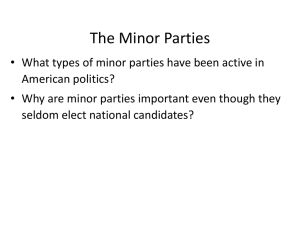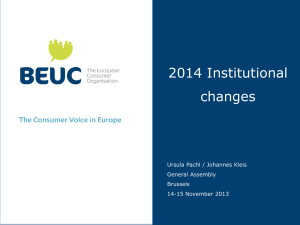Political Parties Review
advertisement
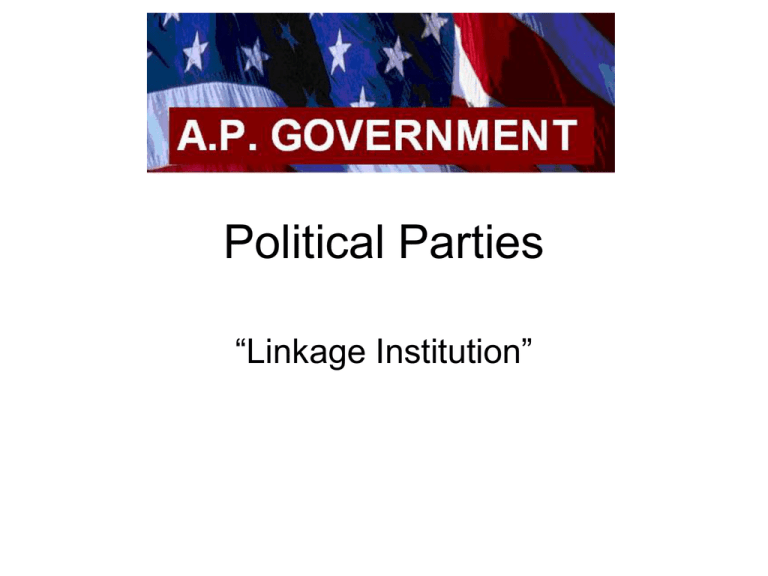
Political Parties “Linkage Institution” What is a political party? • • • • • A political party is a group of voters, activists, candidates, and office holders who identify with a party label and seek to elect individuals to public office. The Evolution of American Party Democracy • Hamilton and Jefferson, as heads of the Federalist and Anti-Federalist groups respectively, are often considered 'fathers' of the modern party system. • By 1800, this country had a party system with two major parties that has remained relatively stable ever since. Goal of a Political Party? • WIN ELECTIONS Party Structure • National Convention – meets every 4 years, nominates President • National Committee – manages party affairs on daily basis • Congressional campaign committee – supports party’s candidates • National chair – manages daily work Function of Parties 1. Connecting citizens to government (linkage institution) -Political Efficacy – citizen participation level and awareness of government decisions 2. Run candidates for political office 3. Inform the public – help voters decide who to vote for in elections 4. Organizing government – coordinate government policy-making Why 2 parties? • Winner-take-all system • Winner receives a seat while loser receives nothing • 3rd party usually joins one of other parties • Opposite – Proportional Representation – % of votes is directly applied as the % of representatives Democrats and Republicans: The Golden Age • From the presidential elections of 1860 to the present, the same two major parties have contested elections in the United States: • Democrats and Republicans. • – Reconstruction -- Republican dominance • Republican party formed 1854 by anti-slavery activists • – 1876-1896 -- closely competitive • – 1896-1929 -- Republican dominance • – 1930s and 1940s -- Democratic dominance • – 1950s and 1960s -- closely competitive • – 1970-2000 -- neither party dominant • Election of 2008—Democratic dominance • Currently—Democrats losing ground in Congressional elections “Grass Roots” • “Grass Roots” – parties can also reach the voters personally and “get-out-the-vote” on a local level One-Partyism • A significant trend of recent times is the demise of one-partyism (one party dominance of elections in a given region). • The formerly "Solid South" is no longer only Democratic. * Many individuals split their vote between the parties, and sometimes vote for third parties. Results of the past 4 Presidential elections Red=The Republican candidate carried the state in all four most recent presidential elections (1996, 2000, 2004, 2008). Pink=The Republican candidate carried the state in three of the four most recent elections. Purple=The Republican candidate and the Democratic candidate each carried the state in two of the four most recent elections. Light blue=The Democratic candidate carried the state in three of the four most recent elections. Dark blue=The Democratic candidate carried the state in all four most recent elections Minor Parties: ThirdPartyism • Minor parties are not a threat to the two major parties. • Only eight third parties have won any electoral votes in a presidential contest. • The third parties that have had some success are: • – 1996 and 1992: Ross Perot’s Reform Party • – 1968: George Wallace’s American Independent Party • – 1924: Robert LaFollette’s Progressive Party • – 1912: Teddy Roosevelt’s Bull Moose Party • – 1856: Millard Fillmore's American Party Minor Parties Third Parties have played a role in politics Types 1. Individual personality – those dominated by one figure head (Ex. – 1912 Theodore Roosevelt – Bull-Moose, 1968 George Wallace – American Independent Party) 2. Long-lasting goal or ideology – (Ex. – Abolitionists, Prohibitionists, Socialists) The Golden Age of Political Parties 1874-1912 • Party stability-rare • Big city and big party organization-political “machines” Chicago • Party was viewed as government-party provided social services directly=patronage and allegiance • Intense devotion=high voter turnout 76% or better in elections form 1876-1900 Modern Era • 1930s-social services began to be provided by national gov. not parties • Direct primaries meant power of party diminished • Loose ties between candidate and party • Post WWII-issue oriented politics • – Individual candidate became focus • – Interest groups rather than party stepped into void • – More ticket splitting-voters vote for candidate as much as the party Party Identification • Dealignment – weak membership, more “independents” or moderates – popular trend in the last 50 years • Strait ticket voting – strong party membership, support all candidates for one party • Ticket splitting – voting for candidates from multiple parties Declining Party Loyalty? • Dealignment-general decline in partisan id • The number of independents in the U.S. rose from 19% in 1958 to 37% twenty years later. • Identification with the two major parties today is in the mid 80% range. • Pollsters often find that many self declared independents often 'lean' quite strongly to either the Democrat or Republican party. • “Leaners” do feel party affiliations, but choose not to self-identify with a party. Realignment • A shifting of party coalition groupings in the electorate that remains in place for several elections • – Jefferson formed Dem-Rep party • – Whig dissolved, Republican emerged won pres. 1860 • – Great Depression-many voters realigned to Dem More on Realignment? • “Gridlock” – Congress and Presidency controlled by different parties • 2004 - Republican sweep of Congress and Presidency - party loyalty stronger? • 2006 - split the Presidency and Congress again • 2008 - brought a Democratic sweep • Mid elections 2010—backlash from economy and BP oil spill + Tea Party MAY see a shift back towards Republican party • Since the early 1980s, the Republican Party platform has been increasingly influenced by A) environmental activists B) evangelical Christians C) civil libertarians D) labor unions E) active military officers • Since 1972, voters in presidential elections have A) become more focused on individual candidates B) increasingly based their votes on televised debates C) become more influenced by party platforms D) become more likely to focus on local rather than national conditions E) become more likely to rely on print media for information • An election in which there is a significant shift in the bases of electoral support from one political party to another is called a A) deviating election B) maintaining election C) realigning election D) primary election E) dealigning election


